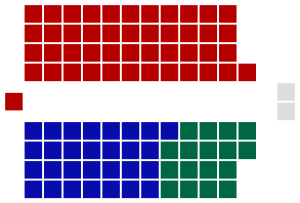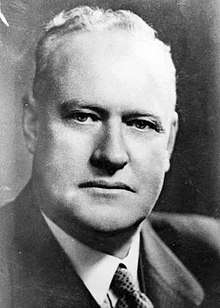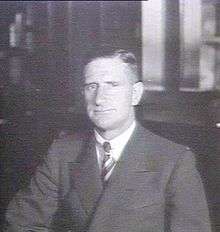1950 New South Wales state election
The 1950 New South Wales state election was held on 17 June 1950. It was conducted in single member constituencies with compulsory preferential voting and was held on boundaries created at a 1949 redistribution. The election was for all of the 94 seats in the Legislative Assembly, which was an increase of 4 seats since the previous election.
| |||||||||||||||||||||||||||||||
All 94 seats in the New South Wales Legislative Assembly 48 Assembly seats were needed for a majority | |||||||||||||||||||||||||||||||
|---|---|---|---|---|---|---|---|---|---|---|---|---|---|---|---|---|---|---|---|---|---|---|---|---|---|---|---|---|---|---|---|
| |||||||||||||||||||||||||||||||
 Legislative Assembly after the election | |||||||||||||||||||||||||||||||
| |||||||||||||||||||||||||||||||
At the time of the election, Labor had been in power for 9 years, James McGirr had been the Premier for 3 years and Labor had lost power federally to the Liberal Party of Robert Menzies 6 months earlier. The NSW Labor Government, under McGirr, was beginning to show signs of age. Severe divisions had appeared in the party at the beginning of 1950 when the state executive expelled 4 members of the Assembly James Geraghty (North Sydney), John Seiffert (Monaro), Roy Heferen (Barwon) and Fred Stanley (Lakemba) from the parliamentary party for breaking party solidarity during an indirect election of the Legislative Council. They had voted for the businessman Asher Joel instead of the endorsed Labor candidates. All four served out the remainder of their terms as independents and stood in the election as Independent Labor candidates. An attempt by the caucus to overturn the expulsions led to resentment among party branch members which was reflected in the defeat of four members who were standing for pre-selection; Baden Powell, Bob Gorman, Mary Quirk and Kevin Dwyer.[1] Two members of Lang Labor: James Lang (Auburn) and Lillian Fowler (Newtown) were still in the Assembly and they both stood for re-election.
In contrast, the Liberal Party which had been founded by in 1945, continued to consolidate its position as the pre-eminent conservative party. It had been led by Vernon Treatt and presented a solid front to the electorate. The Country Party was led by Michael Bruxner and remained closely aligned to the Liberals.
The result of the election was a hung parliament:
- Australian Labor Party 46 seats
- Independent Labor 2 seat
- Liberal 29 seats
- Country Party 17 seats
The balance of power lay with the two re-elected Independent Labor members, James Geraghty and John Seiffert, who had been expelled from the party for disloyalty during the previous parliament. Under a legalistic interpretation of the ALP rules, Seiffert was readmitted to the party and, together with the support of Geraghty, McGirr and Labor were able to stay in power. Labor gained the two Lang Labor seats and re-gained the Independent Labor seat of Lakemba at the election. It lost the remaining seat held by an Independent Labor member (Barwon) to the Country Party. Labor also lost Hawkesbury, Ryde and Kogarah to the Liberal Party and Mudgee and Dubbo to the Country Party. The sitting Independent members for South Coast and Gloucester changed their allegiance to the Liberal Party and the Country Party respectively at this election. During the parliament there were 4 by-elections with the result of a net gain to Labor of 1 seat (Ashfield).
The near loss of the election weakened McGirr's position and he was replaced as premier by Joseph Cahill in April 1952. Treatt remained the Leader of the Opposition during the period of this parliament and Bruxner continued as the Leader of the Country Party, a position he had held since 1932.
Key dates
| Date | Event |
|---|---|
| 22 May 1950 | The Legislative Assembly was dissolved, and writs were issued by the Governor to proceed with an election. |
| 22 May 1950 | Nominations for candidates for the election closed at noon. |
| 17 June 1950 | Polling day. |
| 19 July 1950 | Last day for the writs to be returned and the results formally declared. |
| 12 July 1950 | Opening of 36th Parliament. |
Results
|
New South Wales state election, 17 June 1950 | ||||||
|---|---|---|---|---|---|---|
| Enrolled voters | 1,919,479[lower-alpha 1] | |||||
| Votes cast | 1,611,349 | Turnout | 92.75 | −1,86 | ||
| Informal votes | 28,964 | Informal | 1.77 | −0.22 | ||
| Summary of votes by party | ||||||
| Party | Primary votes | % | Swing | Seats | Change | |
| Labor | 753,268 | 46.75 | + 0.8 | 46 | −2 | |
| Liberal | 604,428 | 37.51 | +7.9 | 29 | +11 | |
| Country | 144,573 | 8.97 | −1.2 | 17 | +2 | |
| Independent | 37,229 | 2.31 | −3.61 | 0 | −2 | |
| Independent Labor | 26,596 | 1.65 | +0.77 | 2 | −2 | |
| Lang Labor | 19,683 | 1.22 | −2.85 | 0 | −2 | |
| Communist | 13,589 | 0.84 | −0.87 | 0 | 0 | |
| Independent Country | 6,445 | 0.40 | +0.40 | 0 | 0 | |
| Independent Liberal | 5,538 | 0.34 | −0.15 | 0 | 0 | |
| Total | 1,611,349 | 94 | ||||
The final two party preferred result was Labor 51% to Coalition 49%.
See also
Notes
- There were 1,768,801 enrolled voters in 86 contested electorates and 150,878 were enrolled in 8 uncontested electorates (5 Country, 2 Liberal and 1 Labor).[2]
References
- "Defeat of Five Members in pre-selection". Sun Herald. 12 March 1950. Retrieved 11 January 2009 – via National Library of Australia.
- Green, Antony. "1950 election totals". New South Wales Election Results 1856-2007. Parliament of New South Wales. Retrieved 9 August 2019.

